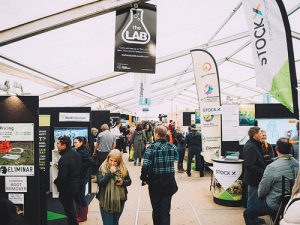Fieldays’ sustainability credentials getting greener
The New Zealand National Fieldays Society has achieved a major sustainability milestone - reducing its greenhouse gas emissions and reaching the target five years early.
 This year marks Fieldays’ 50th year of showcasing agriculture and innovation to rural and urban audiences.
This year marks Fieldays’ 50th year of showcasing agriculture and innovation to rural and urban audiences.
The National Fieldays is calling innovators: join our 50th celebrations and bring your new gadgets along.
Entries have opened for the 2018 National Agricultural Fieldays Innovation Awards.
The awards showcase innovation in dairy and drystock farming, horticulture, information and communication technology, cloud and mobile-based software, animal health and genetics, water and waste management, environment and clean-tech, animal and farm management, farm safety and research.
This year marks Fieldays’ 50th year of showing agriculture and innovation to rural and urban audiences. The theme is ‘Future of Farming’, and visitors and exhibitors are being encouraged to start talking about the future of farming for them.
Fieldays innovations event manager Gail Hendricks says they’re encouraging entries from small, grassroots innovations through to the larger, international innovations.
“We love seeing how widespread our entries are, and have always encouraged the small, grassroots entries just as much as the bigger, more established ones,” says Hendricks.
“Even though an entry might be ‘small’, it can still make a big impact.”
The entries are housed in Fieldays’ Innovations Centre, where entrants can get free advice from lawyers, patent and trademark attorneys, accountants and product development consultants.
Hendricks says ‘Future of Farming’ ties in with the Innovation Awards.
“Originally, the Fieldays Innovation Awards were about widgets, gadgets and devices to improve farming, but increasingly we’re seeing entries that play to the agritech factor and consider how science and technology continues to advance agriculture.”
Awards judge Nigel Slaughter, chief executive of Hamilton molecular extraction company Ligar, says the judges aren’t necessarily looking for the most clever hi-tech of inventions.
“We’re looking for entries that show they’re ahead of the curve, have seen a gap in the market and shown their product is useful for its intended audience,” he says.
“We want to see the thought processes behind the innovation. Have they seen where their product is going to be useful? Is it going to save the user time or money? Have they considered the feedback they received during trials?
“Sometimes innovators spend a good deal of time explaining their own thought processes in getting a new product off the ground, and while that’s an important part of the journey we want to see how they’ve engaged with their audience and incorporated their users’ feedback into their final prototype.”
Legal controls on the movement of fruits and vegetables are now in place in Auckland’s Mt Roskill suburb, says Biosecurity New Zealand Commissioner North Mike Inglis.
Arable growers worried that some weeds in their crops may have developed herbicide resistance can now get the suspected plants tested for free.
Fruit growers and exporters are worried following the discovery of a male Queensland fruit fly in Auckland this week.
Dairy prices have jumped in the overnight Global Dairy Trade (GDT) auction, breaking a five-month negative streak.
Alliance Group chief executive Willie Wiese is leaving the company after three years in the role.
A booklet produced in 2025 by the Rotoiti 15 trust, Department of Conservation and Scion – now part of the Bioeconomy Science Institute – aims to help people identify insect pests and diseases.

OPINION: The release of the Natural Environment Bill and Planning Bill to replace the Resource Management Act is a red-letter day…
OPINION: Federated Farmers has launched a new campaign, swapping ‘The Twelve Days of Christmas’ for ‘The Twelve Pests of Christmas’ to…